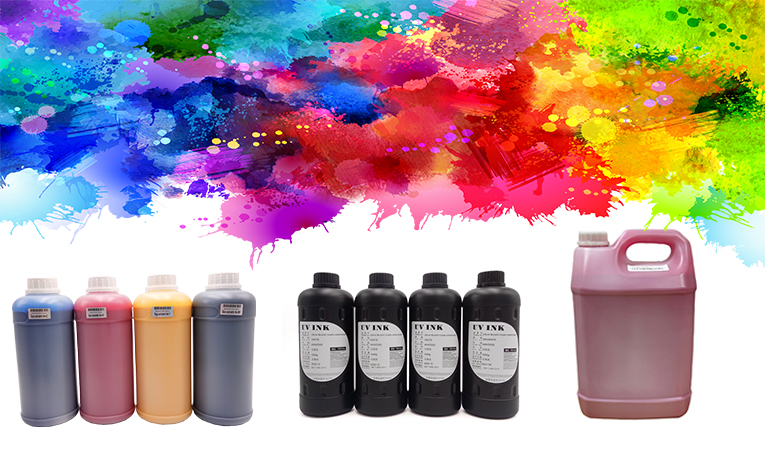How Many Types Of Digital Printing Inks Do You Know?
How Many Types Of Digital Printing Inks Do You Know?
The users of digital printing inks just entering the printing industry must be very confused with many complex types of textile printing inks. Currently, there are several digital printing inks on the market. But do you know which fabrics are suitable for these digital inks?

1. Disperse digital printing ink
The molecular structure of dispersed printing inks is relatively small, and the molecule does not contain water-soluble groups but only polar groups. What’s more, its water solubility is very poor. In water, the particles are mainly dispersed, and these particles are called nonionic dyes. Because the dyes need to form a homogeneous aqueous dispersion with the help of a dispersant, they are called disperse ink for digital printing.
Disperse digital inks are divided into two categories in practical applications: “sublimation transfer inks” and “direct disperse inkjet inks”. The basic properties of these two types of inks are the same. In practical applications, the formulation in some places, such as surface tension and permeability, will be different due to different ink-receiving media. The printing medium of sublimation transfer ink is thermal transfer paper, which is transferred to chemical fiber fabric or polyester-coated surface by high temperature. The dispersed ink for digital printing is mainly used for polyester fabrics such as sportswear and swimwear.
The direct dispersed inkjet ink is directly printed on the surface of chemical fiber fabric or polyester coating; after printing, high-temperature discoloration occurs. Disperse digital inks are similar to media printed with sublimation transfer inks and are also polyester fabrics. Banners in the advertising industry use a lot of these inks due to their direct infusion characteristics. Of course, direct digital inkjet ink can also be used to make images that can be produced by sublimation transfer.
2. Active digital printing ink
The so-called reactive printing ink is a reactive liquid dye. It is an ink widely used in digital printing applications. It has a variety of fabrics, good color fastness and usability, convenience, and other advantages. It can now be applied to fabrics such as cellulose fibers and protein fibers. The main components of reactive printing inks are dyes, demonized water, PH buffers, bactericides, and surfactants. Surfactants have two functions; one is to control the surface tension of the ink to adapt it to the requirements of the digital inkjet printing press.
The piezoelectric nozzles that are widely used today require high viscosity and surface tension. If the viscosity is too high, the nozzles are easily clogged; if it is too low, it is easy for the digital color ink to form a secondary cloth. Usually, the viscosity is controlled at 10-50mPa.s. The surface tension should be controlled between 30-60 dynes/cm, which ensures smooth penetration of the dye into the fiber while maintaining the fineness of the pattern.
Another role of the surfactant is to help the dye enhance the force (also called strength) of the liquid dye. Surfactants are usually selected from glycols or naphthalene sulfonic acids. For example, Sublistar series digital inkjet printing inks are homologs of propylene glycol and sodium naphthalene sulfonate. The role of the biocide is to prevent the molds in the digital printing press from forming and blocking the ink channels. A similar situation occurred in Europe in the early days of digital printing. Reactive inks are mainly used to print cotton fabrics such as T-shirts, dresses, and bed sheets.
3. Acid digital printing ink
Acid digital printing ink is dye ink. In contrast to reactive digital printing inks, the dye components in acid inks for digital printing are acid dyes. Acid inks are bright in color and suitable for fabrics like silk, wool, nylon, etc. Many in the market believe that acid inks for digital printing are highly corrosive, but they are entirely wrong. Acidic inks need to be used under acidic conditions, and they cannot create acid by themselves. They are sometimes more stable than reactive digital printing inks because acid inks do not have hydrolysis issues.
For nozzles, the pH of the acidic digital printing ink can be adjusted to be slightly alkaline, while the reactive ink for digital printing will accelerate its hydrolysis rate under alkaline conditions. However, acid dye inks have large differences in color fastness and reactive inks, and the high-temperature soaking of acid inks is very serious. For fabrics printed with acid digital color inks, the washing temperature should not be too high, up to 50 degrees for silk and wool, and 80 degrees for nylon. There is a famous saying in the industry: acidity cannot be compared with reactive color fastness, and activity cannot be more vivid than acidity. Acid inks are mainly suitable for printing on silk, wool, and nylon fabrics. Some fabrics overlap with fabrics suitable for reactive inks. The actual print will vary due to the composition of the fabric itself.
4. Paint digital printing ink
Paint digital printing ink, also known as pigment ink, is a dispersion composed of particles. To put it bluntly, it is a powder-based-solid pigment dispersion ink. Of course, this is just an image and not accurate enough. To be precise, painting digital color inks are suspension/dispersion solutions or semi-solutions, which are obtained by grinding solid pigments into very fine particles and dispersing them in water or organic solvents by dispersants.
Digital ink and paint are widely used in the textile field and are suitable for printing and dyeing of almost all fiber fabrics, such as cotton, wool, silk, hemp, polyester, nylon, acrylic, and other blended products like cotton T-shirts, towels, carpets, parasols, Oxford cloth, etc. all these fabrics can be made using the digital ink transfer.
